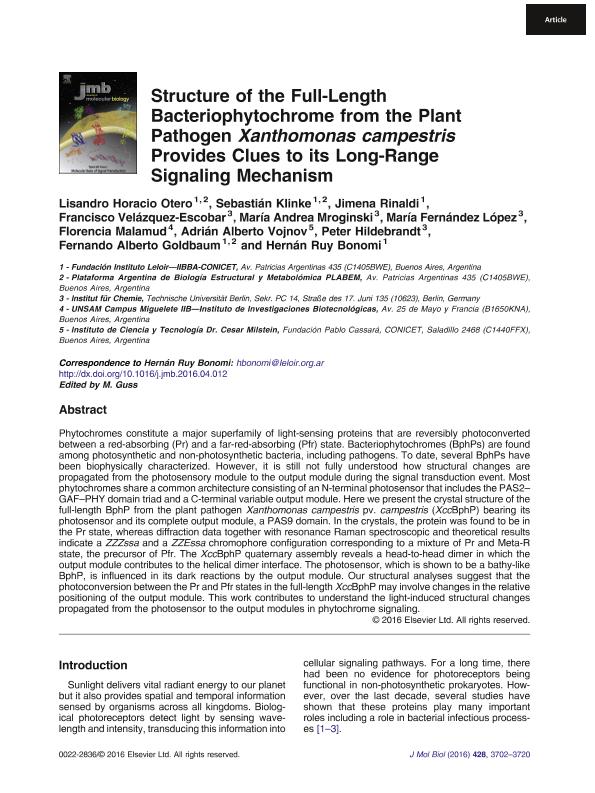Artículo
Structure of the Full-Length Bacteriophytochrome from the Plant Pathogen Xanthomonas campestris Provides Clues to its Long-Range Signaling Mechanism
Otero, Lisandro Horacio ; Klinke, Sebastian
; Klinke, Sebastian ; Rinaldi, Jimena Julieta
; Rinaldi, Jimena Julieta ; Velázquez Escobar, Francisco; Mroginski, Maria Andrea; Fernández López, Maria; Malamud, Florencia
; Velázquez Escobar, Francisco; Mroginski, Maria Andrea; Fernández López, Maria; Malamud, Florencia ; Vojnov, Adrian Alberto
; Vojnov, Adrian Alberto ; Hildebrandt, Peter; Goldbaum, Fernando Alberto
; Hildebrandt, Peter; Goldbaum, Fernando Alberto ; Bonomi, Hernan Ruy
; Bonomi, Hernan Ruy
 ; Klinke, Sebastian
; Klinke, Sebastian ; Rinaldi, Jimena Julieta
; Rinaldi, Jimena Julieta ; Velázquez Escobar, Francisco; Mroginski, Maria Andrea; Fernández López, Maria; Malamud, Florencia
; Velázquez Escobar, Francisco; Mroginski, Maria Andrea; Fernández López, Maria; Malamud, Florencia ; Vojnov, Adrian Alberto
; Vojnov, Adrian Alberto ; Hildebrandt, Peter; Goldbaum, Fernando Alberto
; Hildebrandt, Peter; Goldbaum, Fernando Alberto ; Bonomi, Hernan Ruy
; Bonomi, Hernan Ruy
Fecha de publicación:
25/09/2016
Editorial:
Academic Press Ltd-elsevier Science Ltd
Revista:
Journal Of Molecular Biology
ISSN:
0022-2836
e-ISSN:
1089-8638
Idioma:
Inglés
Tipo de recurso:
Artículo publicado
Clasificación temática:
Resumen
Phytochromes constitute a major superfamily of light-sensing proteins that are reversibly photoconverted between a red-absorbing (Pr) and a far-red-absorbing (Pfr) state. Bacteriophytochromes (BphPs) are found among photosynthetic and non-photosynthetic bacteria, including pathogens. To date, several BphPs have been biophysically characterized. However, it is still not fully understood how structural changes are propagated from the photosensory module to the output module during the signal transduction event. Most phytochromes share a common architecture consisting of an N-terminal photosensor that includes the PAS2-GAF-PHY domain triad, and a C-terminal variable output module. Here we present the crystal structure of the full-length BphP from the plant pathogen Xanthomonas campestris pv. campestris (XccBphP) bearing its photosensor and its complete output module, a PAS9 domain. In the crystals, the protein was found to be in the Pr state whereas diffraction data together with resonance Raman spectroscopic and theoretical results indicate a ZZZssa and a ZZEssa chromophore configuration corresponding to a mixture of Pr and Meta-R state, the precursor of Pfr. The XccBphP quaternary assembly reveals a head-to-head dimer in which the output module contributes to the helical dimer interface. The photosensor, which is shown to be a bathy-like BphP, is influenced in its dark reactions by the output module. Our structural analyses suggest that the photoconversion between the Pr and Pfr states in the full-length XccBphP may involve changes in the relative positioning of the output module. This work contributes to understand the light-induced structural changes propagated from the photosensor to the output modules in phytochrome signaling.
Archivos asociados
Licencia
Identificadores
Colecciones
Articulos(ICT - MILSTEIN)
Articulos de INST.DE CS. Y TECNOLOGIA "DR. CESAR MILSTEIN"
Articulos de INST.DE CS. Y TECNOLOGIA "DR. CESAR MILSTEIN"
Articulos(IIB-INTECH)
Articulos de INST.DE INVEST.BIOTECNOLOGICAS - INSTITUTO TECNOLOGICO CHASCOMUS
Articulos de INST.DE INVEST.BIOTECNOLOGICAS - INSTITUTO TECNOLOGICO CHASCOMUS
Articulos(IIBBA)
Articulos de INST.DE INVEST.BIOQUIMICAS DE BS.AS(I)
Articulos de INST.DE INVEST.BIOQUIMICAS DE BS.AS(I)
Citación
Otero, Lisandro Horacio; Klinke, Sebastian; Rinaldi, Jimena Julieta; Velázquez Escobar, Francisco; Mroginski, Maria Andrea; et al.; Structure of the Full-Length Bacteriophytochrome from the Plant Pathogen Xanthomonas campestris Provides Clues to its Long-Range Signaling Mechanism; Academic Press Ltd-elsevier Science Ltd; Journal Of Molecular Biology; 428; 19; 25-9-2016; 3702-3720
Compartir
Altmétricas



